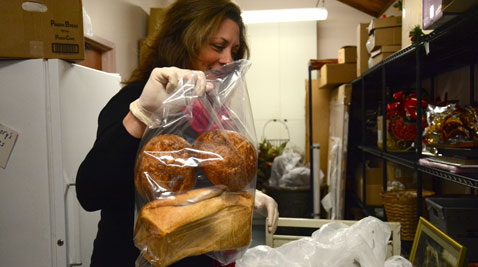A shortage of volunteers has left the Maryland Food Bank struggling to distribute generous holiday-season donations fast enough to meet increased demand at pantries around the state.
The Maryland Food Bank has put out a call for groups of volunteers to help sort the 500,000 pounds of food sitting in its Baltimore County headquarters. The Food Bank’s other two locations, in Washington and Wicomico Counties, have also reported shortages of help.
“The food pantries are waiting for us to give the product, and we just don’t have the manpower among our small staff to be able to get it out fast enough,” said Yvonne Terry, director of development at the Eastern Shore branch in Salisbury. “We need to get it out. We don’t want it sitting here. The food bank is supposed to be … a clearinghouse, and our goal is to get the food in, get the food out.”

According to Kate Sam, director of communications in Baltimore, an average group of 15 to 25 volunteers can sort approximately 10,000 pounds of food in one 3-hour shift, and pantries will have it claimed in a matter of hours.
Demand for the food has been high this winter, with colder than normal temperatures driving up heating costs and families facing food stamp cuts that came in November with the end of a 2009 stimulus package provision that offered a boost to the Supplemental Nutrition Assistance Program.
Sam said the Food Bank receives daily calls from some of their partners requesting more supplies to meet the growing need.
At Fishes & Loaves Pantry in Baltimore, the number of monthly clients has doubled to 3,200 since the food stamp cuts went into effect, according to Rev. Andre Samuel, the pantry’s director.
Samuel trekked to the Food Bank for supplies no more twice a week before the cuts. Now, he goes every day, waking up as early as 3 a.m. to check the online menu where the Food Bank lists the available items for the day, he said.
The menu has been scant lately, Samuel said, not because the Food Bank doesn’t have the items, but because they don’t have the volunteers to sort through them all.
“We feel the pinch of that,” he said.

At the Crofton Food Pantry at St. Elizabeth Ann Seton Catholic Church, director Susan Bixby has also seen an increase in demand, with many clients citing food stamp cuts as the cause. The pantry, which is open three days a week and one Sunday each month, helped 171 families in December, the largest amount ever, according to Bixby, who has worked at the pantry since its inception 2008. Bixby gets most of her supplies from donations and the Anne Arundel County Food and Resources Bank in Crownsville, where executive director Bruce Michalec said he is grateful that he isn’t short on help.
The backlog at the Maryland Food Bank is partly the result of the post-holiday dip in volunteers that comes each year when the facility needs the manpower most. October to December is “food drive season,” according to Sam, when donations often flood into the distribution centers.
The bulk of donations, though, comes from retailers, like Giant and Wegmans, which donate several tractor-trailers full of food each month. These donations, known as “salvage,” often come in large, mixed quantities that need sorting before they can be distributed to the Food Bank’s partners.
“We break it all down so that when our pantries call us, they can get exactly what they need instead of the wide assortment,” said Billie Bedregal, who works at the Western Maryland branch in Hagerstown.

The smaller Western Maryland warehouse can only accommodate five volunteers a day, but the other branches prefer larger groups of volunteers who can deal with mass quantities of food quickly.
The Eastern Shore branch, which serves eight counties, is restructuring its program to attract more groups to help with tasks like marking up barcodes on meat donated from retailers, a required step and an added reason for urgency with the perishable nature of the product, Terry said.
The branch has four or five groups that come in on a regular basis, and it hopes to double that number, she said.
“Until we can get enough volunteers to help us mark all of those out, then the food just sits in the freezer, and it’s not doing us any good to help people if it’s just sitting there,” Terry said. “We have a backlog of that food that we need to get out. We need to get it out soon.”
Capital News Service video by Emily Stern.


You must be logged in to post a comment.